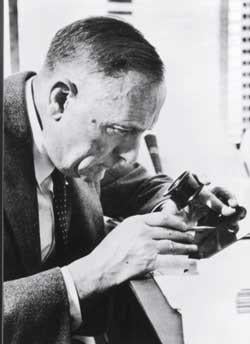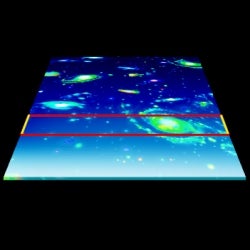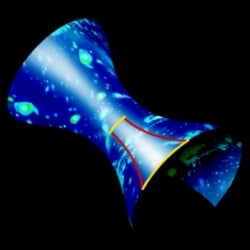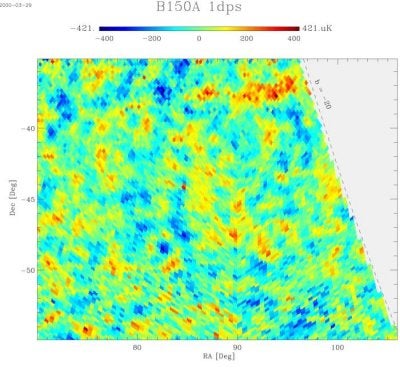Only in the last couple of decades can it be said that cosmology has become a science in the traditional sense, where rigorous theories being developed are compare to precise data. The story starts with the discovery in 1929 by the American astronomer Edwin Hubble that matter in the universe is organized into galaxies and that these galaxies seem to be moving away from us. The farther away a galaxy is, the faster it is receding. The universe at large is expanding.
Hubble’s discovery implied that the universe had a beginning. And although the idea of creation events occurring at a specific time in the past has always been a part of mythology, this was the first time that it became a part of serious scientific discussion. Sometimes the most important contribution a scientist makes is not to supply an answer, but rather to point out that the question can be asked. With Hubble, discussions of the origin and evolution of the universe finally moved from philosophy and mythology to science.
For a long time, it was hard to gather the data needed to deal with cosmological questions. During the 1970s and 1980s, this began to change. People began to realize that if the universe really had its beginning in a hot dense state, the way to understand its origins was to look at how particles interacted with each other at very high energies. The idea is that if a material is at a high temperature, its constituent parts are moving fast and colliding violently with one another. If you can reproduce these collisions in the laboratory, you can go a long way toward understanding the system.
To take one famous example, when the universe was around three minutes old, the collisions were violent enough to tear apart the nuclei of whatever atoms existed at the time. This means that before three minutes, the universe could not have had nuclei in it — even if they formed, they would be quickly destroyed by collisions. After three minutes, on the other hand, the severity of the collisions was sufficiently mild that any nucleus, once created, would survive. The title of one of the most important books for the popular understanding of modern cosmology, Steven Weinberg’s The First Three Minutes, reflects this fact.
The question of how the chemical elements formed out of primordial particles has always been important for cosmologists. In fact, one of the first persons to introduce the notion of a Big Bang — the Russian born cosmologist George Gamow, working at American University in Washington — was attempting to explain the formation of all the chemical elements. He assumed that the universe began in a hot dense ball of hydrogen and tried to use the new science of nuclear physics to show that the evolution of that hot ball of gas would inevitably lead to the kind of chemical elements that we see around us today. He was wrong about this assumption (we now know that all elements beyond lithium are made by nuclear fusion in stars or by other processes), but it put the notion of a Big Bang on the theoretical map.
The application of nuclear physics to the Big Bang really marked a change in the way that scientists thought about the evolution of the universe. It represented a coming together of the science of cosmology and the science devoted to understanding the basic structure of matter. It worked like this: From our theories of the Hubble expansion, we can calculate how often protons will collide with one another in the early universe. From our knowledge of lab results on nuclear reactions we can then see how often these collisions will give rise to a simple atomic nucleus. By combining the two sciences we can come away with an understanding of how many nuclei of each kind of atom were built during the Big Bang. We then turn back to observational astronomy to tell us how many of those atoms are actually present in the universe. This complex interplay of astronomy and nuclear physics has yielded rather extraordinary results over the years, all of it confirming the basic theory. Many astronomers feel that this agreement between prediction and measurement constitutes the most compelling body of proof for the Big Bang.
Moving beyond the building of nuclei, however, proved somewhat difficult. It is one thing to talk about the first three minutes in the life of the universe, but quite another to talk about the first fraction of a second of it. The problem is that the farther back we go in time, the higher the energies of the collisions involved. It wasn’t until the late 1970s that our knowledge of physics at these high energies had progressed to the point where we were able to move ahead.
To understand why this is so, remember that our studies of the fundamental structure of matter have taken us through many layers of reality. We know that molecules are made from atoms, and we know that atoms have a nucleus surrounded by electrons in orbit. We also know that the nucleus is made up of what have come to be called “elementary particles,” the most important of which are the proton and the neutron. The idea is that you put the elementary particles together to make nuclei, add electrons to make atoms, and then shuffle the atoms around to make all of the materials in the universe.
Each time you penetrate to a new layer in this hierarchy, however, the price of entry in terms of energy goes up. A few volts will take an atom apart — in fact, processes like this are going on in the fluorescent bulbs in the building that you are sitting in at the moment. It takes millions of volts to get inside a nucleus, and the ability to do this depended on the building of particle accelerators, which started in the 1930s. To get to elementary particles requires even more energy — tens of billions of volts. Accelerators in this energy scale began to become available in the 1950s and 1960s.
By the end of the 1960s, all of the ingredients of a major new step in our understanding were in place. During this period, theorists like Steven Weinberg began producing theories that would describe the world at these very high energies. Today’s so-called “Standard Model,” our best description of the fundamental structure of matter to date, is a direct descendant of those early theories.
To understand what happened next, you have to understand something about the state of mind of cosmologists in the late 1970s. Looking back, it’s easy to see that the cosmology of the time had gaping holes in it. In particular, we knew enough about the universe that we lived in to realize that there were three fundamental problems that could be addressed because of the new advances in particle theory. These included the flatness, antimatter, and horizon problems.
One question that you can ask about the Hubble expansion is whether it will ever stop. The answer to this question depends on the amount of matter in the universe. Think about a distant galaxy speeding away from Earth. If there is enough matter in the universe, then the gravitational force that it exerts on that galaxy will eventually slow the galaxy down, stop it, and start it moving back inward. A universe with this much matter is said to be closed. It could be that there is not enough matter in the universe to slow down the expansion, which means the galaxy will keep moving outward forever. In this case the universe is said to be open. The transition between these two — a universe with precisely enough matter to slow the expansion down over an infinite amount of time — is called “flat,” and the amount of matter required to create this kind of universe is called the “critical mass density.”
We know that for every particle we find in nature, it is possible to make an antiparticle, a particle of the same mass but with opposite electrical charge. (The antiparticle of the electron, for example, is called the positron. It has the same mass as the electron but a positive electrical charge.) When particle and antiparticle meet, they annihilate each other, converting all their mass to energy. Furthermore, the laws of nature seem to indicate that there is almost no difference between matter and antimatter.
On the other hand, we also know that the universe in which we live is made up almost entirely of matter, and the little bits of antimatter which are around seem to be made from collisions between particles on outer space. So the antimatter problem is this: “If it is really true that matter and antimatter have equal footing at the most fundamental level, why is the universe made only of matter?”













